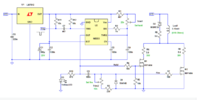Hello
I have asked about this previously. Forgive me for asking again! Some years back, a helpful member simplified a design for me - as shown below. It has come in for criticism but it worked OK. Then it stopped working. I could not find a fault.
Can an expert please see if it looks right? Someone here said the RC timing design was wrong.
It should get one input pulse, and two simultaneous output pulses, one brief, one longer (each able to be varied). Thus, the brief one yields double the voltage of the longer one. Please confirm that the output duration is independent of the input pulse duration.
Thanks
Malc
I have asked about this previously. Forgive me for asking again! Some years back, a helpful member simplified a design for me - as shown below. It has come in for criticism but it worked OK. Then it stopped working. I could not find a fault.
Can an expert please see if it looks right? Someone here said the RC timing design was wrong.
It should get one input pulse, and two simultaneous output pulses, one brief, one longer (each able to be varied). Thus, the brief one yields double the voltage of the longer one. Please confirm that the output duration is independent of the input pulse duration.
Thanks
Malc


